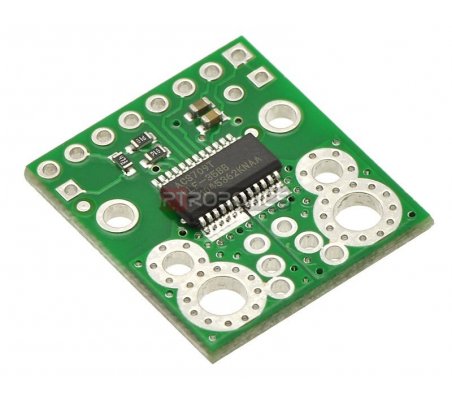ACS709 Sensor de Corrente -75A para +75A
ACS709 Sensor de Corrente -75A para +75A
ACS709 Sensor de Corrente -75A para +75A
Descrição
ACS709 Sensor de Corrente -75A para +75A
Informação do fabricante:
This board is a simple carrier of Allegro’s ±75A ACS709 Hall effect-based linear current sensor with overcurrent fault output, which offers a low-resistance (~1.1 mΩ) current path and electrical isolation up to 2.1 kV RMS. The sensor has optimized accuracy for currents from -37.5 A to 37.5 A, and the analog voltage output is linear for current magnitudes up to 75 A. The ratiometric output voltage is centered at VCC/2 and has a typical error of ±2%. It operates from 3 V to 5.5 V, so it can interface directly to both 3.3 V and 5 V systems.
This current sensor is a carrier board or breakout board for Allegro’s ACS709LLFTR-35BB-T Hall effect-based linear current sensor with overcurrent fault output; we therefore recommend careful reading of the ACS709 datasheet (1MB pdf) before using this product. The sensor has an operating voltage of 3 V to 5.5 V and an output sensitivity of 18.5 mV/A when Vcc is 3.3 V (or 28 mV/A when Vcc is 5 V). The following list details some of the sensor’s key features:
- Optimized accuracy for bidirectional input current from -37.5 A to 37.5 A, with a linear sensing range from -75 A to 75 A (see warning note below for thermal limitations).
- Conductive path internal resistance is typically 1.1 mΩ, and the PCB is made with 2-oz copper, so very little power is lost in the board.
- Integrated shield greatly reduces capacitive coupling from current conductor to die and prevents offset drift in high-side applications.
- Use of a Hall effect sensor means the IC is able to electrically isolate the current path from the sensor’s electronics (up to 2.1 kV RMS), which allows the sensor to be inserted anywhere along the current path and to be used in applications that require electrical isolation.
- 120 kHz bandwidth that can optionally be decreased by adding a capacitor across the board pins marked “FILT”.
- High accuracy and reliability: typical total output error of 2% at room temperature with factory calibration, an extremely stable quiescent output voltage
- Automotive-grade operating temperature range of -40°C to 150°C.
- User-settable overcurrent threshold: FAULT pin output latches low when current exceeds the configured threshold for a duration that can be set through the addition of an external capacitor.
Note: The sensor’s extended -75 A to 75 A range should be limited to transient currents. In our tests, we found that the IC could tolerate 50 A for 20 seconds or 37.5 A for 150 seconds before exceeding its maximum temperature rating of 150°C. Therefore, unless you are taking special steps to keep the IC cool, we recommend limiting continuous currents to under 30 A. Even with a low conductive path resistance of 1.1 mΩ, the board can get hot enough to burn you when the current is in the tens of amps, and the IC does not feature any kind of over-temperature protection, so thermal issues should be taken into consideration for high currents.
For more detailed information, please check this page: https://www.pololu.com/product/2199















